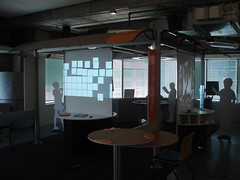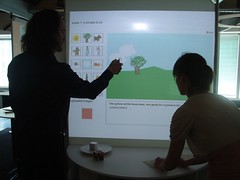Today I saw one possible future for libraries, and it has me pretty excited. I can look back on my professional career and see a progression of advocating for shifting services to where our users are, making our spaces more collaborative, and reinvigorating libraries as the community center (regardless of type of library). It’s why I’ve explored technology, blogging, RSS, social networks, gaming, and collaborative spaces. Today, many of those pieces came together for me in a pretty amazing package that has the power to reimagine the library as third place, cross some digital divides, and integrate participatory culture into our service model. Even better, it involves people and books, not just technology.
 So what did I see today? A project called Thinkering Spaces, conceived of by some very smart people at the Illinois Institute of Technology’s Institute of Design and funded by the MacArthur Foundation. After quite a bit of initial visioning and research, this group has built a prototype for a relatively cheap, portable, collaborative space that can be put up and taken down in libraries of any size on the fly. It’s built using an out-of-the-catalog Steelcase frame, and uses Johnny Lee Chung’s Nintedo wiimote hacks to create an inexpensive, drag-and-drop environment. The technology is as plug and play as it can be to create an open source, open content space where any future technology that is built on these standards can be easily integrated.
So what did I see today? A project called Thinkering Spaces, conceived of by some very smart people at the Illinois Institute of Technology’s Institute of Design and funded by the MacArthur Foundation. After quite a bit of initial visioning and research, this group has built a prototype for a relatively cheap, portable, collaborative space that can be put up and taken down in libraries of any size on the fly. It’s built using an out-of-the-catalog Steelcase frame, and uses Johnny Lee Chung’s Nintedo wiimote hacks to create an inexpensive, drag-and-drop environment. The technology is as plug and play as it can be to create an open source, open content space where any future technology that is built on these standards can be easily integrated.
The point is to bring spaces into libraries that let people collaborate around the content that already exists in in our buildings, add new content to the mix, mash it all up to create something new, and share it with the community. Rinse. Repeat. It’s a way to connect people with the physical world and help them make sense of it by interacting with and changing it. It’s another instance where the library adds value to the equation (the same way it does with books and now games), offering an experience you can’t replicate at home, borne of the community. TJ, the programming wizard behind the curtain, called it a “human interface environment,” rather than a “human computer interaction.” It takes the focus off technology and puts it back onto the people.
 The various pieces are designed for different types of interactions, including:
The various pieces are designed for different types of interactions, including:
- asynchronous
- synchronous
- subscribe to a mentor (one-to-many)
- collaborative storytelling/joint commentary
- cumulative experience (see what others have done and build on it or change it)
Because the space is scalable down to 5′x5′ or expandable up to 12′x12′, it should fit in most buildings in some form. Libraries could assemble the full version one day and only certain pieces the next week. It could be used at specific times for certain programming and then broken down and stored until the next session. It has its own contained wireless network, or it could access the library’s wifi. It’s designed to create a distinct, exploratory environment that doesn’t require anyone to run it.
 Out of all of the discussions and demonstrations today, TJ summed it up best when he said the project is about ” ‘look at what I did,’ as opposed to ‘look at what I bought.’ ” To provide that type of interaction in the safe, non-commercialized third place of the library for the entire community is a pretty exciting prospect. No other entity in the community could provide the breadth and depth of this type of experience. The team at IIT - Dale Fahnstrom, Greg Prygrocki, Heloisa Moura, and TJ - has created a working prototype that dazzles the imagination for the next generation of library services.
Out of all of the discussions and demonstrations today, TJ summed it up best when he said the project is about ” ‘look at what I did,’ as opposed to ‘look at what I bought.’ ” To provide that type of interaction in the safe, non-commercialized third place of the library for the entire community is a pretty exciting prospect. No other entity in the community could provide the breadth and depth of this type of experience. The team at IIT - Dale Fahnstrom, Greg Prygrocki, Heloisa Moura, and TJ - has created a working prototype that dazzles the imagination for the next generation of library services.
Over the next few days, I’ll write more about the details, the plan, and what I hope is the future of the project, but for now you can see my Flickr set of pictures from today’s visit to get an idea of what it looks like and what it can do. Keeping in mind that it’s still in the prototype phase, it’s still pretty inspiring.
collaborative spaces, illinois institute of technology, institute of design, libraries, macarthur foundation, thinkering spaces, third place


